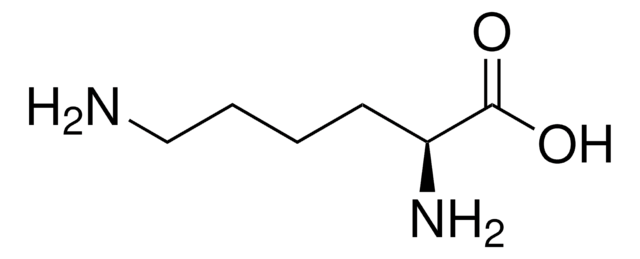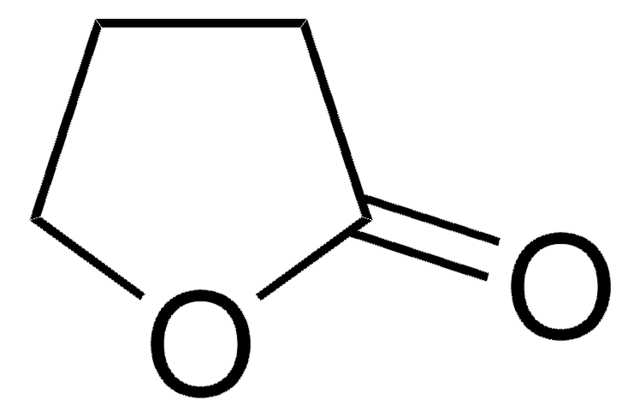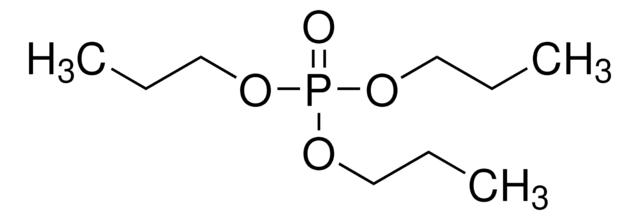62929
L-Lysine monohydrochloride
≥99.5% (AT), suitable for cell culture, BioUltra
Sinónimos:
(S)-2,6-Diaminohexanoic acid monohydrochloride
About This Item
Productos recomendados
product name
L-Lysine monohydrochloride, BioUltra, ≥99.5% (AT)
Línea del producto
BioUltra
Nivel de calidad
Análisis
≥99.5% (AT)
formulario
powder or crystals
actividad óptica
[α]20/D +20.5±0.5°, c = 5% in 5 M HCl
técnicas
cell culture | mammalian: suitable
impurezas
insoluble matter, passes filter test
≤0.3% foreign amino acids
residuo de ign.
≤0.1% (as SO4)
pérdida
≤0.5% loss on drying, 20 °C (HV)
color
white
pH
5.0-6.0 (25 °C, 0.5 M in H2O)
mp
263 °C (dec.) (lit.)
solubilidad
H2O: 0.5 M at 20 °C, clear, colorless
trazas de anión
sulfate (SO42-): ≤100 mg/kg
trazas de catión
Al: ≤5 mg/kg
As: ≤0.1 mg/kg
Ba: ≤5 mg/kg
Bi: ≤5 mg/kg
Ca: ≤10 mg/kg
Cd: ≤5 mg/kg
Co: ≤5 mg/kg
Cr: ≤5 mg/kg
Cu: ≤5 mg/kg
Fe: ≤5 mg/kg
K: ≤50 mg/kg
Li: ≤5 mg/kg
Mg: ≤5 mg/kg
Mn: ≤5 mg/kg
Mo: ≤5 mg/kg
NH4+: ≤100 mg/kg
Na: ≤50 mg/kg
Ni: ≤5 mg/kg
Pb: ≤5 mg/kg
Sr: ≤5 mg/kg
Zn: ≤5 mg/kg
λ
0.5 M in H2O
Absorción UV
λ: 260 nm Amax: 0.1
λ: 280 nm Amax: 0.1
cadena SMILES
OC([C@@H](N)CCCCN)=O.[H]Cl
InChI
1S/C6H14N2O2.ClH/c7-4-2-1-3-5(8)6(9)10;/h5H,1-4,7-8H2,(H,9,10);1H/t5-;/m0./s1
Clave InChI
BVHLGVCQOALMSV-JEDNCBNOSA-N
¿Está buscando productos similares? Visita Guía de comparación de productos
Descripción general
Aplicación
- to study its effect on mRNA decay and destruction using mammalian cells
- to determine its effec on aTC1-6 cell proliferation
- to study the dynamics of the phosphoproteome upon amino acid supplement removal in the growth medium
Acciones bioquímicas o fisiológicas
Código de clase de almacenamiento
11 - Combustible Solids
Clase de riesgo para el agua (WGK)
WGK 2
Punto de inflamabilidad (°F)
Not applicable
Punto de inflamabilidad (°C)
Not applicable
Equipo de protección personal
Eyeshields, Gloves, type N95 (US)
Elija entre una de las versiones más recientes:
¿Ya tiene este producto?
Encuentre la documentación para los productos que ha comprado recientemente en la Biblioteca de documentos.
Los clientes también vieron
Nuestro equipo de científicos tiene experiencia en todas las áreas de investigación: Ciencias de la vida, Ciencia de los materiales, Síntesis química, Cromatografía, Analítica y muchas otras.
Póngase en contacto con el Servicio técnico










